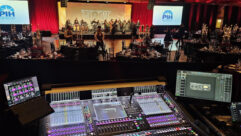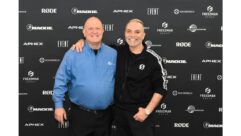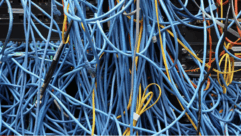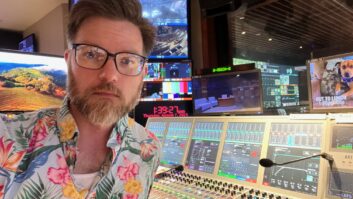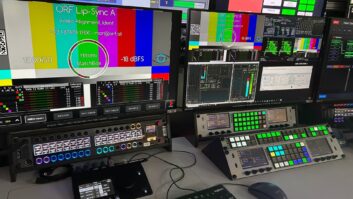Going wireless:
Mar 1, 1998 12:00 PM,
Gil De Liso
The official information system for NSCA Expo ’98 is a portable digitalwireless system called Infowaves that is uniquely designed to distributevoice, visual messaging, data and music throughout the Las Vegas ConventionCenter. Exemplifying the Expo’s theme of Uniting Electronic Technologiesfor the New Millennium, MADAH-Com’s Infowaves is a multimedia eventsponsored by such companies as JBL Professional, Daktronics, QSC Audio,Spirit by Soundcraft, Sennheiser and Atlas/Soundolier, which will furnishloudspeakers and stands. Infowaves will be comprised of eight informationstations throughout the convention center and enable total site coverage infixed or portable installations.
WAVES is an industry innovator because of its use of digital spreadspectrum frequency hopping (SSFH). The system communicates by making thesignal hop from one frequency to another, recognizing the best sequence inwhich to travel and, equally, avoiding frequencies with interference. WAVESuses error-correcting codes and data interleaving techniques for dataprotection. This robust, fault-tolerant network operates license-free andworldwide at 2.4 GHz. The result is clearer sound and data, nonethelesshaving interference-immunity, disaster survivability, ease of installationand sharply reduced costs. This system is unique in that it is the first tooffer such an extensive combination of features.
With such a large, busy trade show floor at NSCA with thousands of membersand over 450 registered exhibitors, it is easy to understand the difficultlogistics involved with communications. Many seminars and other events mustbe announced to the whole convention, as well as all schedule changes, evenlast-minute ones. Special events, such as the many parties given formembers (like the Contractors’ Caper) must all be announced, in addition toany changes, to the entire convention. The different exhibitors, mainlymanufacturers, must also make announcements—messages to salesrepresentatives for meetings and events that are scheduled at all theindividual booths–as well as the obvious need to advertise products.
The official information system for NSCA Expo ’98 is a portable digitalwireless system called Infowaves that is uniquely designed to distributevoice, visual messaging, data and music throughout the Las Vegas ConventionCenter. Exemplifying the Expo’s theme of Uniting Electronic Technologiesfor the New Millennium, MADAH-Com’s Infowaves is a multimedia eventsponsored by such companies as JBL, Daktronics, QSC, Spirit, Sennheiser andAtlas/Soundolier, which will furnish loudspeakers and stands. Infowaveswill be comprised of eight information stations throughout the conventioncenter and enable total site coverage in fixed or portable installations.
Other difficult challenges lie in the convention center itself, which iscurrently under construction. This very large area has partiallyconstructed walkways that tend to confuse pedestrians and will probablylead Expo participants to get lost more than once. The Infowaves systemmust therefore function as a direction kiosk in addition to its otherapplications. The Hilton is headquarters for the Expo as well as the sourceof hotel accommodations for participants and exhibitors. Attendees mustalso receive information about their accommodations and phone calls alongwith efforts to track them.
Infowaves incorporates as its centerpiece MADAH-Com’s WAVES, aPC-controlled network optimized for distribution and monitoring of voice,wide-band music, bi-directional data and I/O control signals. The WAVESsystem is capable of addressing over 16,000 transceivers individuallylocated at any distance from the base station, and each transceiver can actas a full relay. Each wireless transceiver node outputs both amplified andline-level audio, LED display information, and full duplex RS232 data aswell as both analog and digital control signals. Extensive node-levelcontrol of audio (gain, EQ, mute), LED messages, and system layouts iseasily achieved by the WAVES point-and-click software. The system’s keybenefits are ease of installation and reconfiguration, security of data,node addressability, disaster survivability, cost-effectiveness and ADA(Americans With Disability Act) compliance, which is achieved throughsynchronized audio and visual message transmission.
System designers, architects and engineers can now choose speaker placementfor best coverage and maximum intelligibility. Individual units can beequalized for optimum performance, eliminating a troublesome compromiseinherent in traditional constant-voltage distributed audio systems. Systemoperators can monitor and control multiple data devices at each node.Reduced site-survey and pre-planning requirements are typical with a WAVESsystem as are drastically lower installation costs. There is no need forexpensive amplifier rooms, racks of equipment and costly, time-consuminginstallation of feeder cables. Long term, WAVES delivers significantlylower maintenance and reconfiguration costs.
All transceivers are equipped with self-diagnostics to report faultconditions, insuring completely supervised operation. WAVES’ survivabilityis derived from wireless SSFH technology, repeaters and redundancy in thesystem, diversity antenna operations and UPS battery back up for emergencyoperations.
Components of the system in use at the NSCA Show command center include theMADAH-Com Audio/Data Interface Unit (ADU-301), a PC running WAVES MMI(Man-Machine Interface or GUI) software, and. a CRLU-201 base transceiver.Sennheiser has provided the microphones for announcements, and Spirit bySoundcraft has provided the mixing console. At the eight other WAVESstations throughout the convention center (one of which is pictured here)are QSC amplifiers, JBL loudspeakers, Atlas/Soundolier loudspeakers andstands and Daktronics LED signs.
This year, attendees can win prizes in the 1st Annual NSCA Quiz Show,administered by the Infowaves stations. Participants will be able to winvaluable audio gear donated by sponsors as well as a 20-inch (504 mm)TV/VCR donated by NSCA. Everyone is invited to participate.
Infowaves will offer opportunities to exhibitors as well. For the minimal cost of $25, they can advertise their products, the location of their booths, and special events with Infowaves’ audio and LED messages that will be distributedto the entire convention center, including the Hilton Hotel Lobby. Up to 10audiovisual messages, each 15 seconds in length, will be broadcast in anyselected time slot; 20 messages cost only $50. The deadline for admaterials is March 30. All funds collected from advertising will be donatedto charities for the hearing impaired. For sponsors, messaging is free.
New York City based MADAH-Com, winner of the ICIA (InternationalCommunications Industry Association) Manufacturer of the Year Award and theDiscover Magazine Award for Technological Innovation, has a rich backgroundin interference-immune, digital, wireless audio and data communications.MADAH-COM’s website is www.madah.com, and its e-mail address ismadah@erol‘s.com.
Other difficult challenges lie in the convention center itself, which iscurrently under construction. This very large area has partiallyconstructed walkways that tend to confuse pedestrians and will probablylead Expo participants to get lost more than once. The Infowaves systemmust therefore function as a direction kiosk in addition to its otherapplications. The Hilton is headquarters for the Expo as well as the sourceof hotel accommodations for participants and exhibitors. Attendees mustalso receive information about their accommodations and phone calls alongwith efforts to track them.
Infowaves incorporates as its centerpiece MADAH-Com’s WAVES, aPC-controlled network optimized for distribution and monitoring of voice,wide-band music, bi-directional data and I/O control signals. The WAVESsystem is capable of addressing over 16,000 transceivers individuallylocated at any distance from the base station, and each transceiver can actas a full relay. Each wireless transceiver node outputs both amplified andline-level audio, LED display information, and full duplex RS-232 data aswell as both analog and digital control signals. Extensive node-levelcontrol of audio (gain, EQ, mute), LED messages, and system layouts iseasily achieved by the WAVES point-and-click software. The system’s keybenefits are ease of installation and reconfiguration, security of data,node addressability, disaster survivability, cost-effectiveness and ADA(Americans With Disability Act) compliance, which is achieved throughsynchronized audio and visual message transmission.
System designers, architects and engineers can now choose loudspeakerplacement for best coverage and maximum intelligibility. Individual unitscan be equalized for optimum performance, eliminating a troublesomecompromise inherent in traditional constant-voltage distributed audiosystems. System operators can monitor and control multiple data devices ateach node. Reduced site-survey and pre-planning requirements are typicalwith a WAVES system, as are drastically lower installation costs. There isno need for expensive amp rooms, racks of equipment and costly,time-consuming installation of feeder cables. Long term, WAVES deliverssignificantly lower maintenance and reconfiguration costs.
All transceivers are equipped with self-diagnostics to report faultconditions, insuring completely supervised operation. WAVES’ survivabilityis derived from wireless SSFH technology, repeaters and redundancy in thesystem, diversity antenna operations and UPS battery backup for emergencyoperations.
Components of the system in use at the NSCA Show command center include theMADAH-Com Audio/Data Interface Unit (ADU-301), a PC running WAVES MMI(Man-Machine Interface or GUI) software, and a CRLU-201 base transceiver.Sennheiser has provided the mics for announcements, and Spirit bySoundcraft has provided the mixing console. At the eight other WAVESstations throughout the convention center (one of which is pictured here)are QSC Audio amps, JBL Professional loudspeakers, Atlas/Soundolierloudspeakers and stands and Daktronics LED signs.
This year, attendees can win prizes in the First Annual NSCA Quiz Show,administered by the Infowaves stations. Participants will be able to winvaluable audio gear donated by sponsors, as well as a 20 inch (504 mm)TV/VCR donated by NSCA. Everyone is invited to participate.
Infowaves will offer opportunities to exhibitors as well. For the minimalcost of $25, they can advertise their products, the location of theirbooths, and special events with Infowaves’ audio and LED messages that willbe distributed to the entire convention center, including the Hilton HotelLobby. Up to ten A-V messages, each 15 seconds in length, will be broadcastin any selected time slot,with 20 messages costing only $50. The deadlinefor ad materials is March 30. All funds collected from advertising will bedonated to charities for the hearing impaired. For sponsors, messaging isfree.
New York-based MADAH-Com, winner of the ICIA (International CommunicationsIndustry Association) Manufacturer of the Year Award and the DiscoverMagazine Award for Technological Innovation, has a rich background ininterference-immune, digital, wireless audio and data communications.MADAH-COM’s website is www.madah.com, and its e-mail address ismadah@erol‘s.com.
WAVES is an industry innovator because of its use of digital spreadspectrum frequency hopping (SSFH). The system communicates by making thesignal hop from one frequency to another, recognizing the best sequence inwhich to travel and, equally, avoiding frequencies with interference. WAVESuses error-correcting codes and data interleaving techniques for dataprotection. This robust, fault-tolerant network operates license-free andworldwide at 2.4 GHz. The result is clearer sound and data, nonethelesshaving interference-immunity, disaster survivability, ease of installationand sharply reduced costs. This system is unique in that it is the first tooffer such an extensive combination of features.
With such a large, busy trade show floor at NSCA with thousands of membersand over 450 registered exhibitors, it is easy to understand the difficultlogistics involved with communications. Many seminars and other events mustbe announced to the whole convention, as well as all changes in schedule,even last-minute ones. Special events, such as the many parties given formembers (like the Contractors’ Caper) must all be announced (in addition toany changes) to the entire convention, too. The different exhibitors,mainly manufacturers, must also make announcements-messages to salesrepresentatives for meetings and events that are scheduled at all theindividual booths-as well as the obvious need to advertise products.
NSCA’s newly revised Technical Fundamentals of Audio (TFA) training seminarwas debuted recently at Ambassador Enterprises, a systems contractor inPortsmouth, VA. Ted Uzzle led the drill for 24 employees of the company-ahealthy mix of salespeople, bench technicians, senior systems designers andeven a 14-year-old high school student.
Describing it as a rehearsal for the traveling program, Uzzle explainedfurther what took place: “This is a kind of audio technology boot campwhere people come to learn the greatest ideas in fundamental audio.Nobody’s just sitting with eyes glazed over. The way to learn is by doing,and that’s our approach here.”
Topics included the engineering number system, decibels, Ohm’s law,circuits, absorption and reverberation and inverse-square spreading. Theseminar is described as entry level and has been designed to instill adeeper understanding of the basic electronics and acoustics at work inaudio systems-not just for engineers, but also for salespeople, installersand end-users.
Randy Vaughan, president of Ambassador Enterprises and host of the event,summed up the session by saying, “We had the whole company represented.Some of the people in the class knew nothing about technical audio, whilesome were seasoned designers. For the first group, it was a real jumpstart, and for the veterans, I think it was an excellent chance to clarifysome points they’ve always found a bit sticky. Everybody got something goodout of it.”
Employees who attended the seminar didn’t seem to mind the rigorousworkout. In an after-class evaluation session, one attendee remarked, “Thisis the first class I’ve been to that kept you awake, kept you alert.”
Another attendee said, “I think this course has put together the mostuseful information that people can follow in three days of any class I’veever taken.”
Uzzle said the rehearsal was “hugely useful” for him because it has allowedhim to “work out the bugs” and make some final improvements on the coursetextbook and his own delivery before the program takes to the road.
The seminar is scheduled to take place several times in the next fewmonths, and Uzzle explained that the first “tour of duty” is tentativelyset for Phoenix; Las Vegas (NSCA Expo); Atlanta; New Jersey; Dallas;Chicago and Vancouver, Canada. Those interested in learning more about theseminar, including price, registration, event schedule, and course contentshould call NSCA at (800) 446-6722 or (319) 366-6722.


